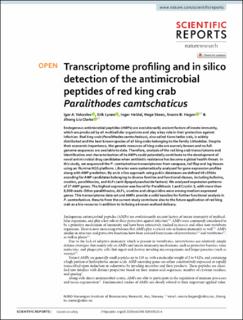Transcriptome profiling and in silico detection of the antimicrobial peptides of red king crab Paralithodes camtschaticus
| dc.contributor.author | Yakovlev, Igor | |
| dc.contributor.author | Lysøe, Erik | |
| dc.contributor.author | Heldal, Inger | |
| dc.contributor.author | Steen, Hege | |
| dc.contributor.author | Hagen, Snorre | |
| dc.contributor.author | Clarke, Jihong Liu | |
| dc.date.accessioned | 2020-10-16T07:33:27Z | |
| dc.date.available | 2020-10-16T07:33:27Z | |
| dc.date.created | 2020-08-19T15:16:55Z | |
| dc.date.issued | 2020-07-29 | |
| dc.identifier.citation | Scientific Reports. 2020, 10 . | en_US |
| dc.identifier.issn | 2045-2322 | |
| dc.identifier.uri | https://hdl.handle.net/11250/2683196 | |
| dc.description.abstract | Endogenous antimicrobial peptides (AMPs) are evolutionarily ancient factors of innate immunity, which are produced by all multicellular organisms and play a key role in their protection against infection. Red king crab (Paralithodes camtschaticus), also called Kamchatka crab, is widely distributed and the best known species of all king crabs belonging to the family Lithodidae. Despite their economic importance, the genetic resources of king crabs are scarcely known and no fullgenome sequences are available to date. Therefore, analysis of the red king crab transcriptome and identifcation and characterization of its AMPs could potentially contribute to the development of novel antimicrobial drug candidates when antibiotic resistance has become a global health threat. In this study, we sequenced the P. camtschaticus transcriptomes from carapace, tail fap and leg tissues using an Illumina NGS platform. Libraries were systematically analyzed for gene expression profles along with AMP prediction. By an in silico approach using public databases we defned 49 cDNAs encoding for AMP candidates belonging to diverse families and functional classes, including buforins, crustins, paralithocins, and ALFs (anti-lipopolysaccharide factors). We analyzed expression patterns of 27 AMP genes. The highest expression was found for Paralithocin 1 and Crustin 3, with more than 8,000 reads. Other paralithocins, ALFs, crustins and ubiquicidins were among medium expressed genes. This transcriptome data set and AMPs provide a solid baseline for further functional analysis in P. camtschaticus. Results from the current study contribute also to the future application of red king crab as a bio-resource in addition to its being a known seafood delicacy. | en_US |
| dc.language.iso | eng | en_US |
| dc.publisher | Springer Nature | en_US |
| dc.rights | Navngivelse 4.0 Internasjonal | * |
| dc.rights.uri | http://creativecommons.org/licenses/by/4.0/deed.no | * |
| dc.title | Transcriptome profiling and in silico detection of the antimicrobial peptides of red king crab Paralithodes camtschaticus | en_US |
| dc.type | Peer reviewed | en_US |
| dc.type | Journal article | en_US |
| dc.description.version | publishedVersion | en_US |
| dc.rights.holder | © The Author(s) 2020 | en_US |
| dc.source.pagenumber | 10 | en_US |
| dc.source.volume | 10 | en_US |
| dc.source.journal | Scientific Reports | en_US |
| dc.identifier.doi | 10.1038/s41598-020-69126-4 | |
| dc.identifier.cristin | 1824114 | |
| cristin.ispublished | true | |
| cristin.fulltext | original | |
| cristin.qualitycode | 1 |
Tilhørende fil(er)
Denne innførselen finnes i følgende samling(er)
-
Divisjon for bioteknologi og plantehelse [523]
Publikasjoner knyttet til ansatte ved Divisjon for bioteknologi og plantehelse -
Divisjon for miljø og naturressurser [747]
Publikasjoner knyttet til ansatte ved Divisjon for miljø og naturressurser -
Divisjon for skog og utmark [520]
Publikasjoner knyttet til ansatte ved Divisjon for skog og utmark -
Publikasjoner fra CRIStin - NIBIO [4531]
-
Vitenskapelige artikler [1416]

